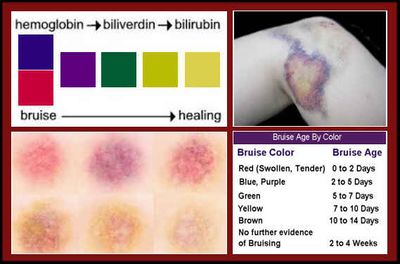Bruise
A bruise, also called a contusion, is a type of relatively minor hematoma of tissue in which capillaries and sometimes venules are damaged by trauma, allowing blood to seep into the surrounding interstitial tissues. Bruises can involve capillaries at the level of the skin, subcutaneous tissue, muscle, or bone.
As a type of hematoma, a bruise is always caused by internal bleeding into the interstitial tissues, usually initiated by blunt trauma, which causes damage through physical compression and deceleration forces. Trauma sufficient to cause bruising can occur from a wide variety of situations including accidents, falls, and surgeries. Disease states such as insufficient or malfunctioning platelets, other coagulation deficiencies, or vascular disorders, such as venous blockage associated with severe allergies can lead to the formation of bruises in situations in which they would not normally occur and with only minimal trauma. If the trauma is sufficient to break the skin and allow blood to escape the interstitial tissues, the injury is not a bruise but instead, a different variety of hemorrhage called bleeding, although such injuries may be accompanied by bruising elsewhere.
Bruises often induce pain, but small bruises are not normally dangerous alone. Sometimes bruises can be serious, leading to other more life-threatening forms of hematoma, such as when associated with serious injuries, including fractures and more severe internal bleeding. The likelihood and severity of bruising depend on many factors, including the type and healthiness of affected tissues. Minor bruises may be easily recognized in people with light skin color by characteristic blue or purple appearance (idiomatically described as "black and blue") in the days following the injury
Mechanism of bruise
Increased distress to tissue causes capillaries to break under the skin, allowing blood to escape and build up. As time progresses, blood seeps into the surrounding tissues, causing the bruise to darken and spread. Nerve endings within the affected tissue detect the increased pressure, which, depending on severity and location, may be perceived as pain or pressure or be asymptomatic. The damaged endothelium (lining) of the affected capillaries releases endothelin, a hormone that causes narrowing of the blood vessel to minimize bleeding. As the endothelium is destroyed, the underlying von Willebrand factor is exposed and initiates coagulation, which creates a temporary clot to plug the wound and eventually leads to the restoration of normal tissue.
During this time, larger bruises may change color due to the breakdown of hemoglobin from within escaped red blood cells in the extracellular space. The striking colors of a bruise are caused by the phagocytosis and sequential degradation of hemoglobin to biliverdin to bilirubin to hemosiderin, with hemoglobin itself producing a red-blue color, biliverdin producing a green color, bilirubin producing a yellow color, and hemosiderin producing a golden-brown color. As these products are cleared from the area, the bruise disappears. Oftentimes the underlying tissue damage has been repaired long before this process is complete.
Size and shape of bruises
Bruise shapes may correspond directly to the instrument of injury or be modified by additional factors. Bruises often become more prominent as time lapses, resulting in additional size and swelling. Bruising present in a different location than the site of impact is called ectopic bruising and occurs when the tissue at the site of injury is loose, allowing blood to travel under the skin to another location due to gravity or other forces, such as in a black eye.
General factors modifying size and shape of bruises
Condition and type of tissue: In soft tissues, a larger area is bruised than would be in firmer tissue due to the ease of blood to invade tissue.
- Age: elderly skin and other tissues are often thinner and less elastic and thus more prone to bruising.
- Gender: More bruising occurs in females due to increased subcutaneous fat.
- Color of skin: Although the same size, bruises are more prominent in lighter complexions.
- Diseases: Coagulation, platelet, and blood vessel diseases or deficiencies can increase bruising due to more bleeding.
- Location: More extensive vascularity causes more bleeding.
- Forces: Greater striking forces cause greater bruising.
- Genetics: Despite having completely normal coagulation factors, natural redheads have been shown to bruise more, although this may just be due to greater visibility on commonly associated lighter complexion
Treatment
Treatment for light bruises is minimal and may include RICE (rest, ice, compression, elevation), painkillers (particularly NSAIDs), and, later in recovery, light stretching exercises. Particularly, immediate application of ice while elevating the area may reduce or completely prevent swelling by restricting blood flow to the area and preventing internal bleeding. Rest and preventing re-injury are essential for rapid recovery.
Very gentle massage of the area and application of heat may encourage blood flow and relieve pain according to the gate control theory of pain, although causing additional pain may indicate the massage is exacerbating the injury. As for most injuries, these techniques should not be applied until at least three days following the initial damage to ensure all internal bleeding has stopped, because although increasing blood flow will allow more healing factors into the area and encourage drainage, if the injury is still bleeding this will allow more blood to seep out of the wound and cause the bruise to become worse.
See also marks#Bruises
Chat rooms • What links here • Copyright info • Contact information • Category:Root
